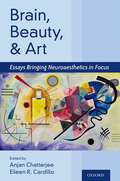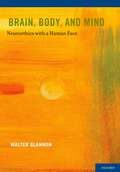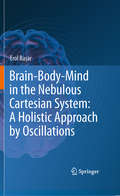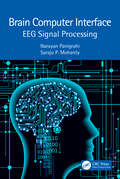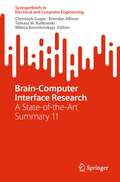- Table View
- List View
The Brain as a Tool: A Neuroscientist's Account
by Ray GuilleryThere are two distinct views about the functions of our brains and their origins. The standard view, taught in most neuroscience texts, has incoming messages about the world sent to the cerebral cortex, with the cortex then producing an appropriate motor output. The interactive view, largely expressed by philosophers and psychologists, stresses the continuous sensorimotor interactions of the brain with the world. The Brain as a Tool focuses on thalamo-cortical interactions on the basis of the interactive view, exploring the phylogenetically new transthalamic corticocortical pathways of mammals that link a hierarchy of cortical areas to each other and back to the phylogenetically older motor centres for control of action. The book demonstrates how messages in these pathways produce an anticipation of our own actions and perceptions. In relating neural events to conscious processing and our sense of self , Guillery summarizes important evidence which links neuroscience with psychology and philosophy. This book is essential reading for neuroscientists, cognitive psychologists and philosophers. Supplemented with a helpful glossary of neural terms and numerous illustrations of the brain, it is also an important resource for graduate and postdoctoral students interested in the neural bases of a sense of self and of cognitive functions.
The Brain as a Tool: A Neuroscientist's Account
by Ray GuilleryThere are two distinct views about the functions of our brains and their origins. The standard view, taught in most neuroscience texts, has incoming messages about the world sent to the cerebral cortex, with the cortex then producing an appropriate motor output. The interactive view, largely expressed by philosophers and psychologists, stresses the continuous sensorimotor interactions of the brain with the world. The Brain as a Tool focuses on thalamo-cortical interactions on the basis of the interactive view, exploring the phylogenetically new transthalamic corticocortical pathways of mammals that link a hierarchy of cortical areas to each other and back to the phylogenetically older motor centres for control of action. The book demonstrates how messages in these pathways produce an anticipation of our own actions and perceptions. In relating neural events to conscious processing and our sense of self , Guillery summarizes important evidence which links neuroscience with psychology and philosophy. This book is essential reading for neuroscientists, cognitive psychologists and philosophers. Supplemented with a helpful glossary of neural terms and numerous illustrations of the brain, it is also an important resource for graduate and postdoctoral students interested in the neural bases of a sense of self and of cognitive functions.
The Brain as an Endocrine Organ (Endocrinology and Metabolism #3)
by Margo Panush Cohen Piero P. FoàIn the middle of the 17th century, the great French philosopher Rene Descartes wrote (L'Homme, J. Le Gras, Paris, 1669) that a suitable stimulation of the brain results in two types of "movements": exterior movements, designed to seek desirable ends and to avoid undesirable or harmful ones and interior movements or "passions" which through the release of "animal spirits" regulate the heart, the liver, and other organs. When it appears appropriate to meet a threat with force, the passion of rage causes the release of strong spirits, whereas when avoidance appears to be the better choice, the passion of fear causes the brain to release weak spirits. We do not know what influence, if any, Descartes had on the thinking of Walter B. Cannon (Bodily Changes in Pain, Hunger, Fear and Rage, Appleton and Co. , New York, 1920), of Hans Selye (The Story of the Adaptation Syndrome, Acta, Inc. , Montreal, 1952), ofG. W. Harris or of R. Guillemin (Hypothalamic-Hypophysial Interrelationships. A Sym posium. c. c. Thomas, Springfield, 1956), but it is interesting to reflect upon the durable value of great ideas which constantly resurface even if modified by other ideas and by new techniques, as if propelled by a preordained intellectual imperative.
Brain Asymmetry and Neural Systems: Foundations in Clinical Neuroscience and Neuropsychology
by David W. HarrisonThe proposed book investigates brain asymmetry from the perspective of functional neural systems theory, a foundational approach for the topic. There is currently no such book available on the market and there is a need for a neuroscience book, with a focus on the functional asymmetry of these two integrated and dynamic brains using historical and modern clinical and experimental research findings with the field. The book provides evidence from multiple methodologies, including clinical lesion studies, brain stimulation, and modern imaging techniques. The author has successfully used the book in doctoral and advances undergraduate courses on neuroscience and neuropsychology. It has also been used to teach a course on the biological basis of behavior and could be used in a variety of contexts and courses.
The Brain at Risk: Associations between Disease and Cognition
by Erin D. Bigler Dawson Hedges Thomas J. Farrer Ramona O. HopkinsThis important book describes the effects of a range of medical, psychological, and neurological conditions on brain functioning, specifically cognition. After a brief introduction of brain anatomy and function focusing on neural systems and their complex role in cognition, this book covers common disorders across several medical specialties, as well as injuries that can damage a variety of neural networks. The authors review findings on associations between these conditions and cognitive domains such as executive function, memory, attention, and learning, and describe possible causal pathways between diseases and cognitive impairment. Later chapters describe potential strategies for prevention, improvement, and treatment. The book’s topics includeCognition in affective disordersCerebrovascular disease and cognitionCognitive sequelae of sepsisTraumatic brain injury and cognitionCognitive deficits associated with drug useObstructive sleep apnea and cognitionCognitive function in pulmonary diseaseThe Brain at Risk reflects the current interest in the links between body, mind, and brain, and will be of great value to researchers and practitioners interested in neuroscience, neuropsychology, and clinical research in the cognitive and behavioral consequences of brain injury and disease.
The Brain Atlas: A Visual Guide to the Human Central Nervous System
by Thomas A. Woolsey Joseph Hanaway Mokhtar H. GadoThe Brain Atlas: A Visual Guide to the Human Central Nervous System integrates modern neuroscience with clinical practice and is now significantly revised and updated for a Fourth Edition. The book's five sections cover: Background Information, The Brain and Its Blood Vessels, Brain Slices, Histological Sections, and Pathways. These are depicted in over 350 high quality intricate figures making it the best available visual guide to human neuroanatomy.
The Brain Atlas: A Visual Guide to the Human Central Nervous System
by Thomas A. Woolsey Joseph Hanaway Mokhtar H. GadoThe Brain Atlas: A Visual Guide to the Human Central Nervous System integrates modern neuroscience with clinical practice and is now significantly revised and updated for a Fourth Edition. The book's five sections cover: Background Information, The Brain and Its Blood Vessels, Brain Slices, Histological Sections, and Pathways. These are depicted in over 350 high quality intricate figures making it the best available visual guide to human neuroanatomy.
Brain Banking (ISSN #Volume 150)
by Ingeborg Huitinga Maree J. WebsterBrain Banking, Volume 150, serves as the only book on the market offering comprehensive coverage of the functional realities of brain banking. It focuses on brain donor recruitment strategies, brain bank networks, ethical issues, brain dissection/tissue processing/tissue dissemination, neuropathological diagnosis, brain donor data, and techniques in brain tissue analysis. In accordance with massive initiatives, such as BRAIN and the EU Human Brain Project, abnormalities and potential therapeutic targets of neurological and psychiatric disorders need to be validated in human brain tissue, thus requiring substantial numbers of well characterized human brains of high tissue quality with neurological and psychiatric diseases. Offers comprehensive coverage of the functional realities of brain banking, with a focus on brain donor recruitment strategies, brain bank networks, ethical issues, and moreServes as a valuable resource for staff in existing brain banks by highlighting best practicesEnhances the sharing of expertise between existing banks and highlights a range of techniques applicable to banked tissue for neuroscience researchersAuthored by leaders from brain banks around the globe – the broadest, most expert coverage available
Brain, Beauty, and Art: Essays Bringing Neuroaesthetics into Focus
by Anjan Chatterjee and Eileen R. CardilloAesthetics has long been the preserve of philosophy, art history, and the creative arts but, more recently, the fields of psychology and neuroscience have entered the discussion, and the field of neuroaesthetics has been born. In Brain, Beauty, and Art, leading scholars in this nascent field reflect on the promise of neuroaesthetics to enrich our understanding of this universal yet diverse facet of human experience. The volume consists of essays from foundational researchers whose empirical work launched the field. Each essay is anchored to an original, peer-reviewed paper from the short history of this new and burgeoning subdiscipline of cognitive neuroscience. Authors of each essay were asked three questions: 1) What motivated the original paper? 2) What were the main findings or theoretical claims made? and, 3) How do those findings or claims fit with the current state and anticipated near future of neuroaesthetics? Together, these essays establish the territory and current boundaries of neuroaesthetics and identify its most promising future directions. Topics include models of neuroaesthetics, and discussions of beauty, art, dance, music, literature, and architecture. Brain, Beauty, and Art will inform and stimulate anyone with an abiding interest in why it is that, across time and culture, we respond to beauty, engage with art, and are affected by music and architecture.
Brain, Beauty, and Art: Essays Bringing Neuroaesthetics into Focus
Aesthetics has long been the preserve of philosophy, art history, and the creative arts but, more recently, the fields of psychology and neuroscience have entered the discussion, and the field of neuroaesthetics has been born. In Brain, Beauty, and Art, leading scholars in this nascent field reflect on the promise of neuroaesthetics to enrich our understanding of this universal yet diverse facet of human experience. The volume consists of essays from foundational researchers whose empirical work launched the field. Each essay is anchored to an original, peer-reviewed paper from the short history of this new and burgeoning subdiscipline of cognitive neuroscience. Authors of each essay were asked three questions: 1) What motivated the original paper? 2) What were the main findings or theoretical claims made? and, 3) How do those findings or claims fit with the current state and anticipated near future of neuroaesthetics? Together, these essays establish the territory and current boundaries of neuroaesthetics and identify its most promising future directions. Topics include models of neuroaesthetics, and discussions of beauty, art, dance, music, literature, and architecture. Brain, Beauty, and Art will inform and stimulate anyone with an abiding interest in why it is that, across time and culture, we respond to beauty, engage with art, and are affected by music and architecture.
Brain, Behavior and Epigenetics (Epigenetics and Human Health)
by Arturas Petronis and Jonathan MillBiomedical research in the first decade of the 21st century has been marked by a rapidly growing interest in epigenetics. The reasons for this are numerous, but primarily it stems from the mounting realization that research programs focused solely on DNA sequence variation, despite their breadth and depth, are unlikely to address all fundamental aspects of human biology. Some questions are evident even to non-biologists. How does a single zygote develop into a complex multicellular organism composed of dozens of different tissues and hundreds of cell types, all genetically identical but performing very different functions? Why do monozygotic twins, despite their stunning external similarities, often exhibit significant differences in personality and predisposition to disease? If environmental factors are solely the cause of such variation, why are similar differences also observed between genetically identical animals housed in a uniform environment? Over the last couple of decades, epigenetics has undergone a significant metamorphosis from an abstract developmental theory to a very dynamic and rapidly developing branch of molecular biology. This volume represents a compilation of our current understanding about the key aspects of epigenetic processes in the brain and their role in behavior. The chapters in this book bring together some of the leading researchers in the field of behavioral epigenetics. They explore many of the epigenetic processes which operate or may be operating to mediate neurobiological functions in the brain and describe how perturbations to these systems may play a key role in mediating behavior and the origin of brain diseases.
Brain, Behaviour, and Iron in the Infant Diet
by John DobbingIron deficiency in infancy is very widespread, even in developed countries and even when there is no general malnutrition. This book examines the question whether iron deficiency in early life leads to deleterious changes in brain and/or behavioural development. Each of the nine contributors comments critically on each of the other eight chapters, so that the book is very extensively peer-reviewed. The evidence is set out so that the reader may make his own informed judgement. Iron deficiency could very easily be prevented; this fact is of prime importance if such deficiency has long-lasting effects on human intellectual capacity and achievement.
Brain Biochemistry (Outline Studies in Biology)
by H. S. BachelardThe brain is the most complex and highly of semi-permeable excitable membranes which specialised of all mammalian organs. Under can be caused, rapidly and transiently, to under standing the complexity of its function remains go changes in permeability to small chemical man's greatest challenge. The functional unit is molecules and to cations. The highly specialised the neurone, or excitable nerve cell, making ana nature of the constituent cells, with their unique tomical and chemical connections with other function and specificity, is c10sely related to units in the system. Many of the essential bio the structure of the whole tissue. The underlying chemical connections of the nerve cell are de chemical processes cannot be discussed or seen pendent upon special morphological features: in perspective without constant awareness of synaptic contact is mediated by chemical mol related aspects of physiology and morphology. ecules, 'neuro-transmitters' which ensure the The hrain is structurally extraordinarily com continued propagation of electrical impulses plex in its distinct anatomical regions, each of through sequential units of the system. Also which is heterogeneous in the types and struc c10sely related to the morphology of the ner tures of the constituent cells. vous system is the chemical energy expended in One aspect of the biochemical function of maintaining distribution gradients of cations the brain can be seen in its efficient production across cellular membranes. Chemical neuro of the energy required to support the unique pro transmission results in an alteration in cation cesses referred to above.
Brain, Body, and Mind: Neuroethics with a Human Face
by Walter GlannonThis book is a discussion of the most timely and contentious issues in the two branches of neuroethics: the neuroscience of ethics; and the ethics of neuroscience. Drawing upon recent work in psychiatry, neurology, and neurosurgery, it develops a phenomenologically inspired theory of neuroscience to explain the brain-mind relation. The idea that the mind is shaped not just by the brain but also by the body and how the human subject interacts with the environment has significant implications for free will, moral responsibility, and moral justification of actions. It also provides a better understanding of how different interventions in the brain can benefit or harm us. In addition, the book discusses brain imaging techniques to diagnose altered states of consciousness, deep-brain stimulation to treat neuropsychiatric disorders, and restorative neurosurgery for neurodegenerative diseases. It examines the medical and ethical trade-offs of these interventions in the brain when they produce both positive and negative physical and psychological effects, and how these trade-offs shape decisions by physicians and patients about whether to provide and undergo them.
Brain, Body, and Mind: Neuroethics with a Human Face
by Walter GlannonThis book is a discussion of the most timely and contentious issues in the two branches of neuroethics: the neuroscience of ethics; and the ethics of neuroscience. Drawing upon recent work in psychiatry, neurology, and neurosurgery, it develops a phenomenologically inspired theory of neuroscience to explain the brain-mind relation. The idea that the mind is shaped not just by the brain but also by the body and how the human subject interacts with the environment has significant implications for free will, moral responsibility, and moral justification of actions. It also provides a better understanding of how different interventions in the brain can benefit or harm us. In addition, the book discusses brain imaging techniques to diagnose altered states of consciousness, deep-brain stimulation to treat neuropsychiatric disorders, and restorative neurosurgery for neurodegenerative diseases. It examines the medical and ethical trade-offs of these interventions in the brain when they produce both positive and negative physical and psychological effects, and how these trade-offs shape decisions by physicians and patients about whether to provide and undergo them.
Brain-Body-Mind in the Nebulous Cartesian System: A Holistic Approach by Oscillations
by Erol BaşarBrain-Body-Mind in the Nebulous Cartesian System: A Holistic Approach by Oscillations is a research monograph, with didactical features, on the mechanisms of the mind, encompassing a wide spectrum of results and analyses. The book should appeal to scientists and graduate students in the fields of neuroscience, neurology, psychiatry, physiology, psychology, physics and philosophy. Its goals are the development of an empirical-analytical construct, denoted as “Reasonings to Approach the Mind”, and the comprehension of 20 principles for understanding the mind. This book amalgamates results from work on the brain, vegetative system, brains in the evolution of species, the maturing brain, dynamic memory, emotional processes, and cognitive impairment in neuro-psychiatric disorders (Alzheimer, Schizophrenia, Bipolar disorders). The findings are comparatively evaluated within the framework of brain oscillations and neurotransmitters. Further, a holistic approach links the brain to the cardiovascular system and overall myogenic coordination of the vegetative system. The results emphasize that EEG oscillations, ultraslow oscillations, and neurotransmitters are quasi-invariant building blocks in brain-body-mind function and also during the evolution of species: The temporal domain is where the importance of research on neural oscillators is indispensable. The core, holistic concept that emerges is that the brain, spinal cord, overall myogenic system, brain-body-oscillations, and neurotransmitters form a functional syncytium. Accordingly, the concept of “Syncytium Brain-Body-Mind” replaces the concept of “Mind”. P>
Brain Chemistry and Mental Disease: Proceedings of a Symposium on Brain Chemistry and Mental Disease held at the Texas Research Institute, Houston, Texas, November 18–20, 1970 (Advances in Behavioral Biology #1)
by Beng T. Ho and William M. McIsaacThis volume contains the proceedings of the fourth international symposium held in November 1970 at the Texas Research Institute of Mental Sciences in Houston. Leading psychiatrists, biochemists, and pharmacologists from the United States and Great Britain presented new material and reviewed current concepts concerning schizophrenia and the affective disorders, with particular reference to the neurochemical basis of the etiology and chemotherapy of these diseases. Although the multiple mechanisms of mental disease are still not fully understood, substantial progress has definitely been made. The greatest contribution has come through the development of new therapeutic agents that not only provide invaluable help to the mentally ill but serve as chemical tools for studying the biological mechanisms associated with the disease state. Studies concerning the proposed catecholamine and indolealkylamine hypotheses for affective disorders and the possible formation of endogenous. toxins in schizophrenia have stimulated significant new research. This book presents new studies of schizophrenia and the affective disorders in one volume. It is our hope that it represents an effective integration of basic biochemical and pharmacological research with current clinical findings and that it will increase understanding of the etiology of mental disease and provide an impetus for the development of more effective therapeutic agents. We thank Drs. Gordon Farrell, Samuel Gershon, A. Horita, Irwin Kopin, and Joseph Schildkraut for their help with the organization of the meeting and for chairing the corresponding sessions.
Brain Computations: What and How
by Edmund T. RollsIn order to understand how the brain works, it is essential to know what is computed by different brain systems, and how those computations are performed. Brain Computations: What and How elucidates what is computed in different brain systems and describes current computational approaches and models of how each of these brain systems computes. This approach has enormous potential for helping us understand ourselves better in health. Potential applications of this understanding are to the treatment of the brain in disease, as well as to artificial intelligence, which will benefit from knowledge of how the brain performs many of its extraordinarily impressive functions. Pioneering in its approach, Brain Computations: What and How will be of interest to all scientists interested in brain function and how the brain works, whether they are from neuroscience, or from medical sciences including neurology and psychiatry, or from the area of computational science including machine learning and artificial intelligence, or from areas such as theoretical physics.
Brain Computations: What and How
by Edmund T. RollsIn order to understand how the brain works, it is essential to know what is computed by different brain systems, and how those computations are performed. Brain Computations: What and How elucidates what is computed in different brain systems and describes current computational approaches and models of how each of these brain systems computes. This approach has enormous potential for helping us understand ourselves better in health. Potential applications of this understanding are to the treatment of the brain in disease, as well as to artificial intelligence, which will benefit from knowledge of how the brain performs many of its extraordinarily impressive functions. Pioneering in its approach, Brain Computations: What and How will be of interest to all scientists interested in brain function and how the brain works, whether they are from neuroscience, or from medical sciences including neurology and psychiatry, or from the area of computational science including machine learning and artificial intelligence, or from areas such as theoretical physics.
Brain Computer Interface: EEG Signal Processing
by Narayan Panigrahi Saraju P. MohantyBrain Computer Interface: EEG Signal Processing discusses electroencephalogram (EEG) signal processing using effective methodology and algorithms. This book provides a basic introduction to EEG and a classification of different components present in EEG. It also helps the reader to understand the scope of processing EEG signals and their associated applications. Further, it covers specific aspects such as epilepsy detection; exploitation of P300 for various applications; design of an EEG acquisition system; and detection of saccade, fix, and blink from EEG and EOG data. Key Features: Explains the basis of brain computer interface and how it can be established using different EEG signal characteristics Covers the detailed classification of different types of EEG signals with respect to their physical characteristics Explains detection and diagnosis of epileptic seizures from the EEG data of a subject Reviews the design and development of a low-cost and robust EEG acquisition system Provides mathematical analysis of EEGs, including MATLAB® codes for students to experiment with EEG data This book is aimed at graduate students and researchers in biomedical, electrical, electronics, communication engineering, healthcare, and cyber physical systems.
Brain Computer Interface: EEG Signal Processing
by Narayan Panigrahi Saraju P. MohantyBrain Computer Interface: EEG Signal Processing discusses electroencephalogram (EEG) signal processing using effective methodology and algorithms. This book provides a basic introduction to EEG and a classification of different components present in EEG. It also helps the reader to understand the scope of processing EEG signals and their associated applications. Further, it covers specific aspects such as epilepsy detection; exploitation of P300 for various applications; design of an EEG acquisition system; and detection of saccade, fix, and blink from EEG and EOG data. Key Features: Explains the basis of brain computer interface and how it can be established using different EEG signal characteristics Covers the detailed classification of different types of EEG signals with respect to their physical characteristics Explains detection and diagnosis of epileptic seizures from the EEG data of a subject Reviews the design and development of a low-cost and robust EEG acquisition system Provides mathematical analysis of EEGs, including MATLAB® codes for students to experiment with EEG data This book is aimed at graduate students and researchers in biomedical, electrical, electronics, communication engineering, healthcare, and cyber physical systems.
Brain-Computer Interface Research: A State-of-the-Art Summary (SpringerBriefs in Electrical and Computer Engineering)
by Christoph Guger, Brendan Z. Allison and Günter EdlingerBrain-computer interfaces (BCIs) are rapidly developing into a mainstream, worldwide research endeavor. With so many new groups and projects, it can be difficult to identify the best ones. This book summarizes ten leading projects from around the world. About 60 submissions were received in 2011 for the highly competitive BCI Research Award, and an international jury selected the top ten. This Brief gives a concise but carefully illustrated and fully up-to-date description of each of these projects, together with an introduction and concluding chapter by the editors.
Brain-Computer Interface Research: A State-of-the-Art Summary 6 (SpringerBriefs in Electrical and Computer Engineering #6)
by Christoph Guger Brendan Allison Mikhail LebedevThis book presents compact and informative descriptions of the most promising new projects in brain-computer interface (BCI) research. As in earlier volumes in this series, the contributions come from many of the best-known groups in BCI research. Each of these chapters provides an overview of a project that was nominated for the most prestigious award in the BCI community: the Annual BCI Research Award. The book also contains an introduction and discussion with a review of major trends reflected in the awards. This volume also introduces a new type of contribution, namely a chapter"Trends in BCI Research" that summarizes a top trend in the BCI research community. This year's "Trends in BCI Research" addresses BCI technology to help patients with disorders of consciousness (DOC) and related conditions, including new work that goes beyond communication to diagnosis and even prediction.
Brain-Computer Interface Research: A State-of-the-Art Summary -2 (Biosystems & Biorobotics #6)
by Christoph Guger Brendan Allison E. C. LeuthardtThis book reports on the latest research and developments in the field of brain-computer interfaces (BCIs). It introduces ten outstanding and innovative BCI projects, nominated as finalists for the BCI award 2012 by a jury of established researchers and discusses how each of the nominated projects reflects general worldwide trends in BCI development. At the core of the book, nine of these ten projects are described in detailed individual chapters. These include a focused introduction to each project, an easy to grasp description of the methods and a timely report on the most recent developments achieved since the submission to the award. Hence, this book provides a cutting-edge overview of the newest BCI research trends, from leading experts, in an easy to read format supported by explanatory pictures, graphs and figures.
Brain-Computer Interface Research: A State-of-the-Art Summary 11 (SpringerBriefs in Electrical and Computer Engineering)
by Christoph Guger Brendan Allison Tomasz M. Rutkowski Milena KorostenskajaThis book showcases recent trends in brain-computer interface development. It highlights fascinating results in areas such as language decoding, spinal cord stimulation to enable gait and to restore hand functions. The contributions are based on the 12 nominated brain-computer interface projects of the BCI Award 2022. Every year an international jury selects the most innovate BCI projects and nominates 12 projects before selecting the 1st, 2nd and 3rd place winners. In the book, each project is described in detail by the team of scientists behind it, and the editors provide a concluding discussion of the highlights and overall progress in the field.






